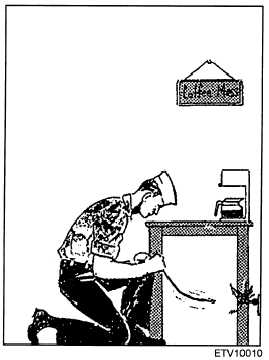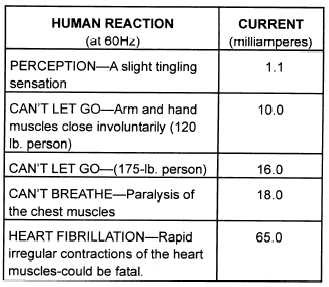your left hand to either foot. The second path is the
MOST dangerous path since the current will flow
through both your heart and your vital organs.
Amount of Body Resistance
Your body resistance varies greatly in different
parts of your body. A value of 1500 ohms is commonly
used as the resistance between major extremities of an
average human body: hand to hand, or hand to foot.
Let’s use Ohm’s Law to figure how much current would
flow through your body if you accidentally grabbed a
wire carrying 120 volts alternating current (vac).
Table 3-1.—Electric Shock Effects
Ohm’s Law for figuring current is I = E/R.
Let E = 120 VAC—The voltage you grabbed
Let R = 1500 Ohms—Your (average) body
resistance
Now let’s compute it.
I = 120/1500
I = .080
I = 80 milliamperes
So if you grabbed a 120-vac wire, 80 milliamperes
of current would flow through your body. Now use
table 3–1 to determine the effect of 80 milliamperes of
electric shock. You can see that you may not be around
long enough to grab any more wires. You grabbed 80
milliamps of current! That’s 15 milliamps beyond what
could be fatal. It’s also 70 milliamps beyond the can’t-
let-go threshold, and 62 milliamps beyond what is
needed to cause you to stop breathing.
It’s important to remember that the 1500 ohms is
just an average value. Body resistance varies from
person to person and may often be LESS than 1500
ohms. When your skin is moist, your body resistance
could be as low as 300 ohms. Also, breaks in your skin
at the point of contact reduce your skin resistance to
nearly zero.
Skin resistance is only important when you’re
handling voltages of less than 240 volts. If you get
shocked by more than 240 volts, the voltage arc will
burn through your skin and leave deep third-degree
bums where it enters your body.
Time of Current Flow
The longer you’re being shocked, the more chance
there is for your heart to begin fibrillation. Fibrillation is
the shocking of your heart into a useless flutter. Most
people who die from electric shock die from fibrillation.
Fibrillation in a normal adult is unlikely if the current in
milliamperes is less than 116/t, where t is the shock
duration in seconds. The longer you are shocked, the
less current is needed to cause heart fibrillation. Here
are some examples of shock current levels and
durations that would cause fibrillation:
21 milliamperes for 30 seconds
44 milliamperes for 7 seconds
3-2




